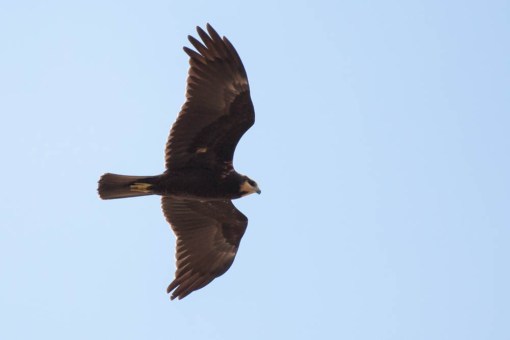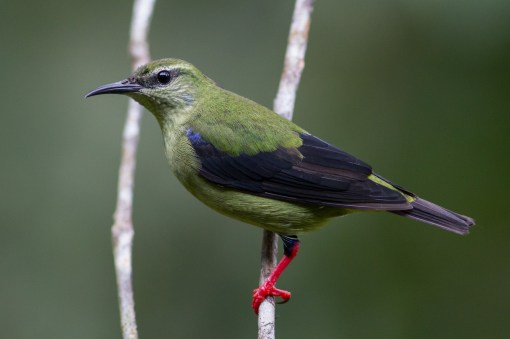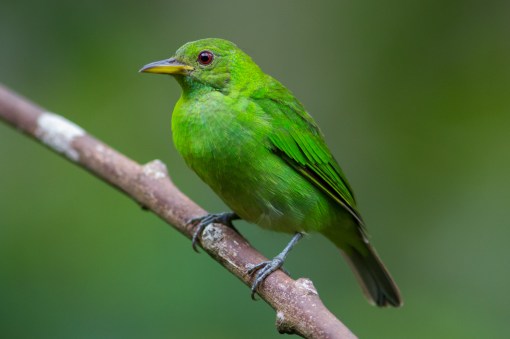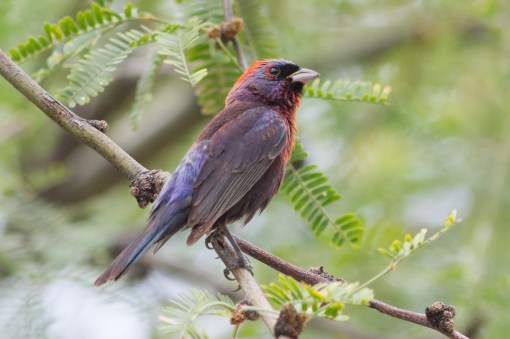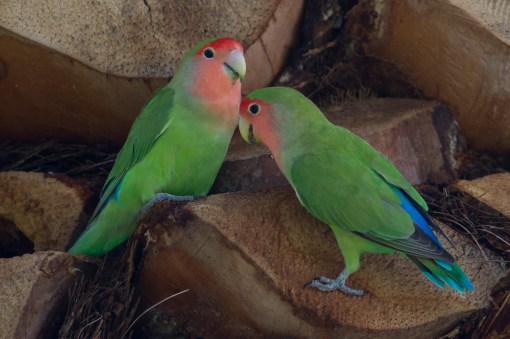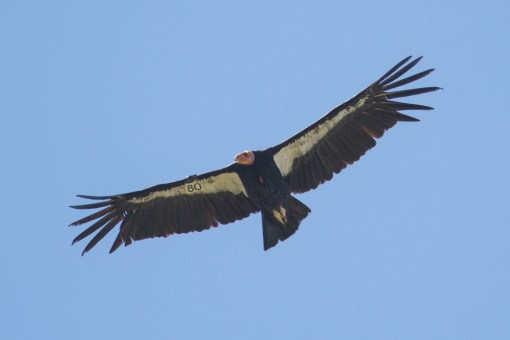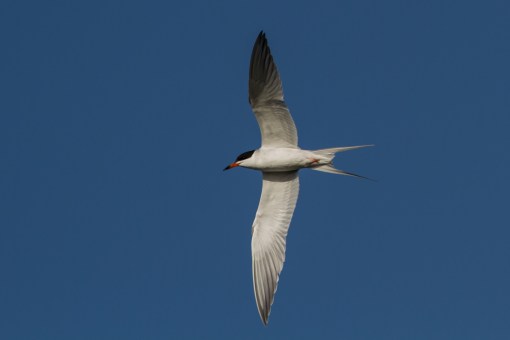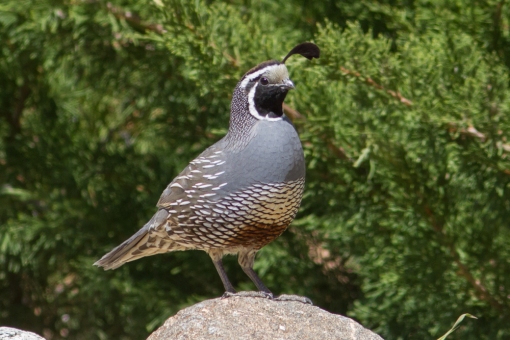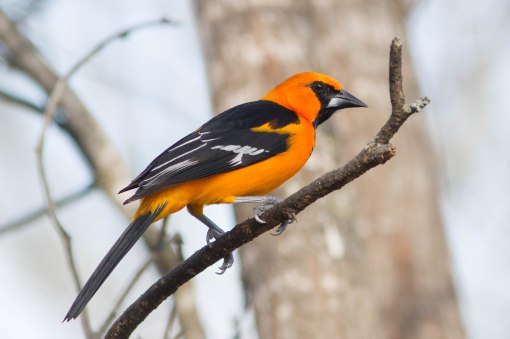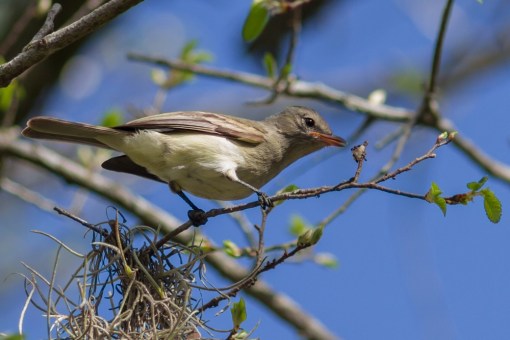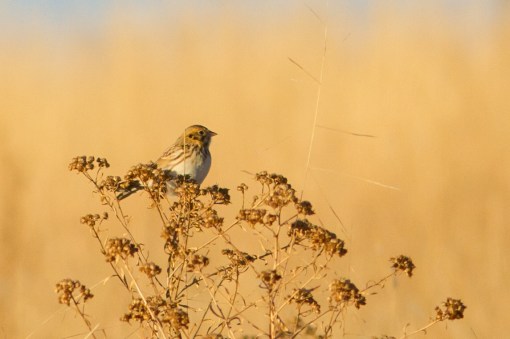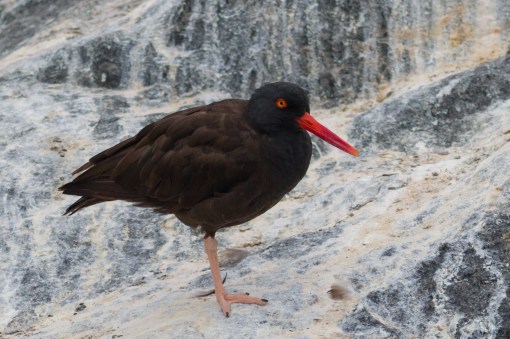
Palm Tanager – Luke Tiller
Panama, not just a terrible Van Halen track! In November 2014 I had seen reports of a flight of raptors that had blackened skies around Panama City and closed the airport there for a couple of days. In total the flight had been calculated to include an incredible two million birds, all seen from the Cerro Ancon Hawkwatch in downtown. From there the seed of this tour with HMANA had been planted. With some help from Jenn, Carlos, Elba and the crew at Canopy Family that dream became a reality three years later.
With nature and hawkwatching there are no guarantees, but we had put ourselves in the time frame for a potentially interesting trip and with Carlos Bethancourt as our guide I was confident we would have a great week whatever happened.

Green Honeycreeper – Luke Tiller
Day 1
Our tour started Saturday morning with transfers from the airport, via a couple of hotels, to Canopy Tower. As you make your way through downtown Panama it’s hard to miss the three large and ubiquitous black birds circling constantly over the city: Black Vulture, Turkey Vulture and most excitingly Magnificent Frigatebird! There were a few other interesting birds as we wended our way through city streets including drive by glimpses of Fork-tailed Flycatcher and Wood Stork.
A little over an hour later we arrived at the world-famous Canopy Tower. It’s a fantastic one-of-a-kind lodge converted from an old US military radar installation. We arrived to a warm welcome from Carlos Bethancourt (our trusty guide for the week) and a selection of drinks and snacks. With some of the group arriving a little later in the day, the initial arrivals had a chance to grab some coffee and head to the lodge roof, home of Semaphore Hill Hawkwatch, for the first of many enjoyable hours spent observing birds above the canopy of Soberania National Park.
It didn’t take long before we were picking up our first interesting raptors of the tour in the shape of hunting Short-tailed and Zone-tailed Hawks. Though only found on the extreme edges of the USA, both of these species are at least possible to encounter in the US. There were a couple of non-raptor species around the tower that were more or less familiar to many of our group too including Red-eyed Vireo, Swainson’s Thrush, Tennessee Warbler and Eastern Wood-Pewee. It was however a novel experience to have Bay-breasted Warbler as the somewhat ever-present warbler species of the trip, dare one call something so pretty a trash bird even jokingly?
The remainder of the group arrived late afternoon from the airport and post introductions we headed out to the rooftop platform to enjoy the last few hours of sunlight. As well as the avian migrants from points north, the wandering flocks of wintering birds also contained many local delights, which included both the ever-present Palm and Plain-colored Tanagers as well as species that merely flitted in and out of our presence at the tower. These roving bird flocks comprised of both the cryptic: Plain Xenops, Olivaceous and Cocoa Woodcreeper as well as the dazzling: Bay-headed Tanager, Blue Dacnis and Green Honeycreeper!
A wonderful evening meal, a couple of bottles of wine and a bottle of Tequila brought in from Mexico by a participant helped cap a nice relaxing introductory day to the Canopy Tower.

White-whiskered Puffbird – Luke Tiller
Day 2
This morning we awoke to the usual reveille at the Canopy Tower: Mantled Howler Monkey and Great Tinamou. As the sun climbed above the local hills our group could be found drinking in both coffee and the sights and sounds of the forest surrounding us. As the trees lit up around us, so more species from home would appear: Summer Tanager, Chimney Swift and Blackburnian Warbler as would more exotic ones too like Mealy Parrot, Tropical Gnatcatcher and Black-breasted Puffbird.
As the day heated up we picked up our first migrating raptors of the trip, after zero movement the day before thanks to some blocking weather on the Costa Rican border. The inclement weather in Costa Rica seemed to have delayed much of the flight through Panama and so among the expected Turkey Vultures and Swainson’s Hawks were proportionally significant groups of Broad-winged Hawks, with even a few adults still in the mix. After breakfast we ventured from our canopy perch down to the base of the lodge tower where we picked up the resident hummingbird species attending their feeders: White-vented Plumeleteer, Blue-chested Hummingbird, White-necked Jacobin and a rather stunning Long-billed Hermit.
A hike down the road that leads to the lodge to the main road revealed many new species for the trip including some real crowd pleasers like White-whiskered Puffbird, Red-capped Manakin and Fasciated Antshrike. Before our return for lunch we also added another adorable hummingbird species to our day’s tally: Violet-bellied.
Post lunch we headed for Panama Viejo, which at first appears to be just a somewhat inauspicious parking lot over an expanse of mudflats. The mudflats however are alive with a wealth of shorebirds including the familiar: Western Sandpipers and the less familiar: Southern Lapwings. There was much else to enjoy too including stunning Cocoi Herons out on the flats and around us in the trees more avian treasures including Sapphire-throated Hummingbird, Saffron Finch and “Mangrove” Yellow Warblers.
There were also some signs of raptor movement overhead, mainly in the form of large kettles of Turkey Vultures streaming eastwards in the thousands. With the Turkey Vultures we picked up a couple of other migrants including a late juvenile Mississippi Kite and a couple of Peregrine Falcons. Though not migrating, a beautiful Common Black Hawk put in a quick appearance too.
This stop at Panama Viejo must rate among one of my favorite parking lot birding experiences of all time. As well as the birds it was also fun to share our birdwatching experience with the Panamanians visiting the museum and cultural center dedicated to the history of the area. Panama Viejo is the site of the oldest European settlement on the Pacific coast of the Americas and is a UNESCO World Heritage Site.

Yellow-billed Cuckoo – Luke Tiller
Day 3
Our day started with a Mottled Owl alarm call and coffee on the tower viewing platform. Post breakfast we headed for the world-famous Pipeline Road. This road and the pipeline it was built to provide access to were constructed during World War II but the pipeline never actually went into service. Now it is perhaps one of the premier birding areas in both Panama and the region generally.
First stop was at the Ammo Dump Ponds, a place where explosives were stored by the US Army and that is now an area used to store explosives for construction by the Panama Canal Authority. The little ponds there can be excellent for water loving species and we soon had a host of them including beautiful Rufescent Tiger-Herons (named for the cryptic plumage of the juvenile), Wattled Jacanas and Purple Gallinules. We could hear the rolling rattle calls of White-throated Crake too, but none appeared to particularly want to be seen.
In the trees and brush around the pond there were plenty of other birds to enjoy including an incredibly showy Yellow-billed Cuckoo. Along with Black-striped Sparrow and Variable Seedeater, another show stopper at the ponds was a singing Isthmian Wren. This somewhat localized and recently split wren species performed well for the group as we uncovered more and more new trip birds.
Behind us flowed the river chagres and coursing over it were a steady stream of swallows, including Southern Rough-winged Swallow, Mangrove Swallow and the ubiquitous Gray-breasted Martins. Joining the hirundines in the sky were a couple of highly desired raptors: White Hawk and Snail Kite. These two beauties were morning highlights for our raptor aficionado group.
We had barely arrived at Pipeline Road proper, when Carlos heard the mournful call of a Streak-chested Antpitta. Springing into action, our tour group all worked well together to make sure that all got great looks at this skulky and highly prized denizen of the forest floor. While we were patiently trying to eke out looks at this cryptic bird we also managed to get good looks at an easy to hear but difficult to see Great Tinamou, as one seemingly wandered in to see what all the excitement was about. A furtive forest dwelling twofer right at the entrance of Pipeline Road!
We had hardly made it around the first bend in the road before a mixed flock of species descended upon us. As birds swarm around you it’s sometimes hard to keep up with the action, as different birds appear within the melee. Again, our group worked hard to get everyone on the different birds as they flitted past us.
Antbirds are something of the draw on Pipeline and a bunch of them were passing through our patch of forest: Fasciated Antshrike, Black-crowned Antshrike and a personal favorite Dot-winged Antwren. For every enigmatic antbird, there was a much showier denizen of the forest appearing including Slaty-tailed, Black-tailed and the recently renamed Gartered Trogon. In the end we had walked less than a few hundred yards down the Pipeline Road, so thick was it with birds.
We ended our morning visit with an audience with a Great Potoo, perhaps the most cryptic resident of the local forest, found perched in a somewhat favored spot. All this and it was only just time for lunch!
After a hearty lunch we headed up to the platform at the Canopy Tower where we joined Semaphore Hill hawk counter Katrina Hucks for an outstanding little rush of hawk migration ahead of a storm front. Initially we had spotted a few very distant kettles of pepperspots, but within a few minutes we found ourselves being inundated by Turkey Vultures and Swainson’s Hawks as roughly 30,000 drifted northeastwards away from Panama City and over our platform aerie (Hawkcount data here). Among this rush of migrating birds, we picked out a few other desired raptors including a beautiful adult King Vulture and a Semiplumbeous Hawk that was perched atop a tree in the canopy out front of the platform. Having counted relatively large movements of raptors before it was amazing to be overwhelmed by such a compressed mass movement of birds riding ahead of the day’s rain.
We ended our day with another wonderful meal at the Canopy Tower which was accompanied by a spectacular Black-and-White Owl perched out in the forest surrounding the dining room. A magnificent end to another incredible day.
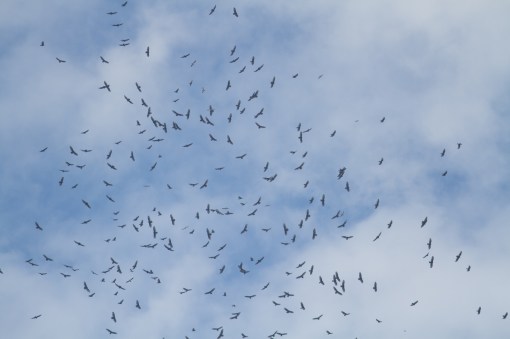
Vulture and hawk kettle – Luke Tiller
Day 4
With the previous day’s flight of raptors in our mind Carlos and I decided that our plan for the day should revolve around Panama City and our eyes should always be partly watching the skies for raptor movement.
After battling a little Panama City traffic, we started our morning at the Parque Natural Metropolitano near downtown. Here one can find a wealth of dry or pacific slope species including such prized birds as Golden-collared and Lance-tailed Manakin. Again, it didn’t take long to get into a mixed flock of birds and among the species revealed we found everything from the relatively prosaic: Northern Waterthrush and Chestnut-sided Warbler to the highly desired: Rufous-breasted Wren, Red-throated Ant-tanager and Panama Flycatcher. More exploring along the park’s trails also uncovered Red-crowned Ant-tanager and Orange-billed Sparrow. Highlights of our stop also had to include Whooping Motmot, our first Bat Falcon and a mammal in the shape of an adorable Rothschild’s Porcupine!
As we birded, I could tell Carlos’s raptor Spidey-sense was tingling as strongly as mine and we decided to head to look at what was happening with the hawk migration. As soon as we reached some open skies it was obvious what was happening; things were going bananas! Leaving the park, we paused briefly along the roadside at the Marcos A. Gelabert Airport to watch a growing liftoff of vultures that were surely grounded by yesterday’s afternoon rain.
From there Carlos steered our bus towards a downtown city park from which to watch the ever-growing kettles and streams of passing raptors. We arrived at Cinta Costera park just in time for the skies to be filled with raptors, and over the next couple of hours watched as Panama City tallied its second highest single day number of migrant Turkey Vultures of all time: 715,517 in total! Perusing Hawkcount when we got home, this was the just the third largest Turkey Vulture day ever recorded at any hawkwatch anywhere in the world! Hawk people talk reverentially of million bird hawkwatches and yet we had almost just seen that number in one single day!
As the skies filled with raptors, our minds were filled with conquistador descriptions of skies being blackened by birds as they surely witnessed this very same migration hundreds of years prior. Though the flight was somewhat homogenous we reveled in the sheer mind-blowing spectacle. In among the huge numbers of Swainson’s Hawks (134,260) there were good numbers of Broad-winged Hawks (27,646) and a smattering of other species: Mississipi Kites, Peregrines, Ospreys and Wood Storks. Even the seemingly unpromising downtown park around us was providing a bounty of nice birds including a handful seen only here on our trip: Boat-billed Flycatcher, Gray Kingbird and most excitingly, out on the bay, a gorgeous Blue-footed Booby or two!
We spent the next three hours reveling in this incredible spectacle while sharing our experience with park visitors: Panamanians and tourists alike. We even had a brief interview with journalists from a local blog that highlights things to do in Panama. The best part of the morning though was having Rosabel Miro from Panama Audubon join us for an hour or so to meet the group and talk about Cerro Ancon Hawkwatch.
Though hard to tear ourselves away, we headed for lunch downtown before heading off to the Quarry Heights area to enjoy the continuation of the flight. We finally left the continuing stream of birds in order to avoid getting stuck in the post work rush hour traffic. An incredible day that I’m sure will live long in the memories of those that witnessed it! There is some great video of the incredible day shot by one of the participants on youtube (here) and details of course on Hawkcount here!

Tiny Hawk – Carlos Bethancourt
Day 5
Our fifth day in Panama started with a bang, when pre-breakfast atop the tower we found ourselves face to face with a stunning Tiny Hawk! It seems like Carlos and I have incredible luck together when it comes to discovering difficult to find accipiters (last time we were together we found a very accommodating juvenile Bicolored Hawk) and I was amazed to find myself staring at this remarkable little raptor as it flew in to join us for morning coffee! It stuck around long enough for most of the group to rush upstairs to see it before disappearing off into the park below. A great start to the day!
Post breakfast we found ourselves hotfooting it from the hummingbird feeders at the Panama Rainforest Discovery Center (where we had picked up Crowned Woodnymph and for a lucky few Purple-crowned Fairy) out to the entrance of the center. Here we found ant swarm that one of Carlos’s fellow guides had called us about. We spent the next hour or so watching as antbirds and more came in to pick off insects escaping the marauding army ants. Highlights around the swarm including amazingly accommodating Spotted and Bicolored Antbird, Northern Barred-Woodcreeper and a small flock of Gray-headed Tanagers.
Earlier in the morning Carlos had managed to tease both Song Wren and Black-faced Antthrush into view for us. Both are charismatic birds, with one mainly memorable for the way it struts around the forest floor, the other for it’s amazing refrain! Morning had also seen us add trogon number four to our trip list: a stunning male Black-throated Trogon. Before we left the Rainforest Discovery Center, we had just enough time to do a little shopping, have Carlos present the Discovery Center with a donated spotting scope and even pick up another great raptor for the tour: Hook-billed Kite. A wonderful action-packed morning of birds.
After lunch we finally had some rain catch up with us. It was green season, so I had anticipated getting a bit wet at least once on the tour. We’d had a fairly successful stop at Summit Ponds with both Boat-billed Heron and American Pygmy Kingfisher in the bag when Carlos, spotting the enveloping clouds, decided we needed to head for shelter. Unfortunately, our ride to the ponds was in an open top bus and as we hit the road homeward bound the heavens opened. Thus ensued a hilariously rain lashed ride back to the Canopy Tower with much laughter and “gallows” humor from everyone involved. A little rain wasn’t going to get this great group down!
We ended our day, with the expert help of one of our participants and a black light, exploring some of the remarkable moths and other nocturnal creatures that call Soberania National Park home (link to amazing moth photos here). An enjoyable end to another great day in Panama.
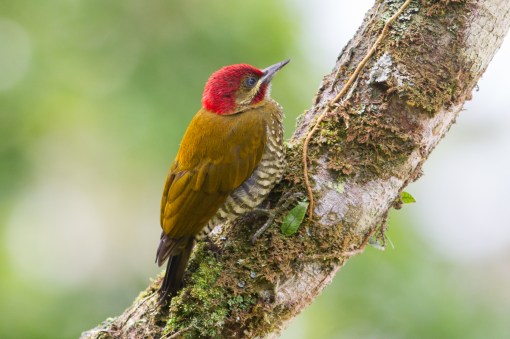
Stripe-cheeked Woodpecker – Luke Tiller
Day 6
This day saw us heading out early to visit the highlands of Cerro Azul. As we meandered across Panama City, we finally managed to knock House Sparrow off our Panama needs list. A huge relief to everyone involved I’m sure. The Cerro Azul Visitors Center provided for a welcome restroom and coffee break, but also saw us picking up some good birds in the nearby gardens including a bevy of beautiful tanagers: Golden-headed, Crimson-backed and Bay-headed.
Our morning birding basically involved short drives and stops at areas where birds appeared or looked productive for specific species. First up was an appointment with a highly prized Panamanian endemic: Stripe-cheeked Woodpecker. We were trying to work looks at one when a Merlin suddenly came careening through our patch of woods thoroughly spooking this beautiful green woodpecker. As if to compound matters a relatively rare Sharp-shinned Hawk circled the area putting everything else to flight. When we finally re-found the woodpecker, we were treated to an incredibly accommodating views of a male bird right at head height. An unusual but very welcomed situation!
Other opportune stops saw us adding more new species including Streaked Saltator, Yellow-faced Grassquit and a much puzzled over Acadian Flycatcher. It was really fun to work through the identity of this silent little empidonax flycatcher on its winter grounds.
After a little more stop-start driving, we reached an area where we parked in order to go on a little hike. As per usual though our hiking was abruptly halted by a mixed tanager flock. Here we uncovered a different selection of tropical jewels including Speckled, Black-and-yellow and Emerald Tanagers. Highlight personally though was the spiffy looking and obliging Scale-crested Pygmy-Tyrant that posed for our photos.
Next stop was the appropriately named Hummingbird House. Here a varied arrangement of feeders played host to not only hundreds of hummingbirds, but a wide variety of nectar, rice and fruit eating species. These included many stunning birds that comprised three types of Honeycreeper: Shining, Red-legged and Green. Also chowing down were Thick-billed Euphonia, Hepatic Tanager and a lonely Bananaquit. The hummingbirds were however certainly stars of the show. They included: Bronze-tailed Plumeleteer – a beautiful large hummingbird with bubblegum pink feet, Green Hermit another giant hummingbird with an amazing scimitar like bill, and perhaps most excitingly the near endemic Violet-capped Hummingbird. This array of birds was all enjoyed while devouring a delicious lunch on the porch of our generous hosts.
After the incredible hummingbird experience, we had just a little more time to enjoy a couple more roving flocks and a riverside stop to pick up a couple of Black Phoebes. We also enjoyed watching a few passing raptors soar overhead before setting off for home. A wonderful end to a productive day in the highlands.

Spotted Antbird – Luke Tiller
Day 7
Sadly our last full day together! As we gathered to head out for one last adventure on the Pipeline Road we were visited in the Canopy Tower parking lot by a couple of beautiful birds: precisely two Cinnamon Woodpeckers and one Green Shrike Vireo. A very nice start to the day’s proceedings.
After a quick stop along the route for a perched raptor, which turned out to be an adult Broad-winged Hawk, we arrived at Pipeline Road. This time we drove in a little way enjoying birds along the road, including nice looks at both Rufous and Whooping Motmots. The open top vehicle proving perfect for laid-back lazy birding.
We finally reached an area where we needed to walk to get any further. As we parked, we picked up the sounds of raucous Black-chested Jays. I wondered aloud whether they were mobbing something or simply jays being jays. With Carlos working the group closer to them we soon had our answer: they were mobbing. Target of the aforementioned mobbing was a stunning juvenile Collared Forest Falcon. Incredibly this had been top of at least one participants wish/hit list for our last day together. Again, in a difficult situation, our trusty group of leaders and participants worked diligently to get everyone on the bird. Though the falcon was moving around constantly, trying to avoid the pursuing corvid harassment squad, and even though we were momentarily distracted by a cool frog everyone finally got to see this secretive forest raptor.
Next on the day’s wish list was White-tailed Trogon. Without much ado, Carlos uncovered one for us: trogon number five for the tour. As we walked the Pipeline Road trail we ran into other desirable new species including a roving flock of Purple-throated Fruitcrows, a couple of tiny and adorable Pied Puffbirds and a quiet and secretive Russet-winged Schiffornis. With lunch beckoning we headed back to our parked vehicle. On the way to the truck we picked up another exciting new raptor: a pair of striking Gray-lined Hawks, a species recently split from the Gray Hawk which is found in southern extremities of the US.
Our tour began to draw to a close with us wishing fond farewells to our guide for the week, Carlos Bethancourt. The group and I then spent a fun afternoon at the amazing Miraflores Locks. While we soaked up the history of this incredible feat of engineering and listened in awe to the descriptions of the boats passing through the locks, we also carefully tallied 41 bird species from the lock observation deck. These included our first Gray-headed Chachalacas of the tour, nice views of a pair of Bat Falcons and perhaps best of all great looks at a Ringed Kingfisher that was pointed out by one of the lock museum staff.
We ended our day with a few cold beverages, another great meal and fond farewells to new friends who were departing early in the morning to catch their flights.
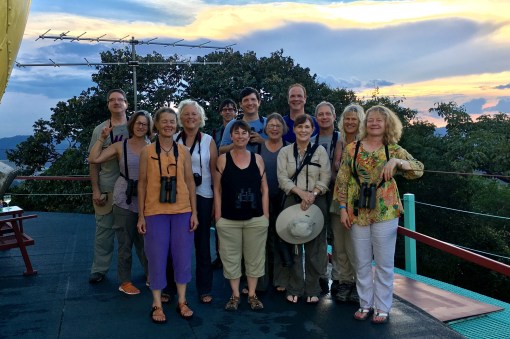
The Group – Luke Tiller
Day 8
This morning there was just enough time to spend another relaxing morning atop the Canopy Tower enjoying breakfast to the sights and sounds of the jungle before having to wish heartfelt goodbyes to the group. Half of the participants made their way to the airport, while others headed for some further adventures in Panama.
To summarize, we had spent a wonderful week at this one-of-a-kind lodge with a group of likeminded people who had now become friends. We had been lucky enough to witness amazing birds, intriguing flora and fauna and astonishing spectacles. Over the week the group had tallied an impressive 266 species of birds and seen flights that had tallied over one million migrating raptors. An amazing trip and one that I personally can’t wait to do all over again with Carlos at the Canopy Tower next year!
For details on next year’s tour, check my tours page (here). For more photos from the tour check my Flickr page (here). PDF of bird species checklist from the tour (Panama Migration Spectacular Birds 2017).
